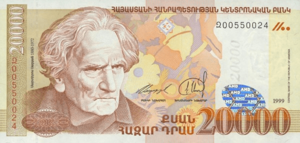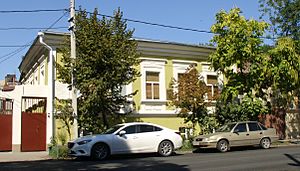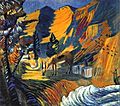Martiros Saryan facts for kids
Quick facts for kids
Martirosyan mard
|
|
|---|---|
 |
|
| Born | 28 February [O.S. 16 February] 1880 Nakhichevan-on-Don, Don Voisko Oblast, Russian Empire
|
| Died | 5 May 1972 (aged 92) |
| Nationality | Armenian |
| Known for | Painter |
|
Notable work
|
Armenia, Morning at Stavrino, Burning Heat with a Dog Running, and In the Grove at Sambek |
| Awards |
|
Martiros Saryan (Armenian: Մարտիրոս Սարյան; Russian: Мартиро́с Сарья́н; February 28, 1880 – May 5, 1972) was a famous Soviet Armenian painter. He is known as the founder of a modern Armenian style of painting.
Biography
Martiros Saryan was born into an Armenian family. This happened in Nakhichevan-on-Don, which is now part of Rostov-on-Don, Russia. In 1895, when he was 15, he finished school in Nakhichevan.
From 1897 to 1904, he studied art at the Moscow School of Arts. He learned from famous teachers like Valentin Serov and Konstantin Korovin. He was also inspired by the works of well-known artists such as Paul Gauguin and Henri Matisse. Saryan showed his paintings in many art shows, including the "Blue Rose" exhibit in Moscow.
Saryan first visited Armenia in 1901. At that time, Armenia was part of the Russian Empire. He traveled to many places like Lori, Shirak, Echmiadzin, and Sevan. During this trip, he painted his first landscapes of Armenia. Some of these paintings include Makravank (1902), Aragats (1902), and Buffalo. Sevan (1903). These early works were highly praised by art critics in Moscow.
Between 1910 and 1913, Saryan traveled a lot. He visited countries like Turkey, Egypt, and Iran. In 1915, he went to Echmiadzin to help Armenians. They were refugees who had fled from a very difficult time in the Ottoman Empire. In 1916, he traveled to Tiflis (now Tbilisi). There, he married Lusik Agayan. In Tiflis, he also helped create the Society of Armenian Artists.

After the government in Russia changed in 1917, Saryan and his family moved to Russia. In 1921, they moved to Armenia. Most of his art showed the beautiful landscapes of Armenia. He also designed the official symbol (coat of arms) for the Armenian SSR. He even designed the curtain for the first Armenian state theater. He suggested a design for Armenia's flag, using colors and patterns from traditional Armenian fabrics. However, his idea was not chosen.
From 1926 to 1928, Saryan lived and worked in Paris. Sadly, many of his paintings from this time were lost in a fire. This happened on the ship he took back to the Soviet Union. From 1928 until he passed away, Saryan lived in Soviet Armenia.
During the tough 1930s, he focused mostly on painting landscapes. He also painted many portraits of people. He was recognized for his work and received important awards. These included the Order of Lenin three times. He was also a member of important art and science academies.
Martiros Saryan died in Yerevan on May 5, 1972. His former home in Yerevan is now a museum. It displays hundreds of his artworks. He was buried in Yerevan at the Pantheon. This is a special burial place for famous people, and he rests next to the composer Komitas Vardapet.
His son, Ghazaros (Lazarus) Saryan, became a composer and teacher. His great-granddaughter, Mariam Petrosyan, is also a painter. She is also a cartoonist and a novelist who has won awards.
Gallery
-
The reverse of the 1999 5000 Dram banknote bears a Lori landscape painting by Saryan
See also
 In Spanish: Martirós Sarián para niños
In Spanish: Martirós Sarián para niños











